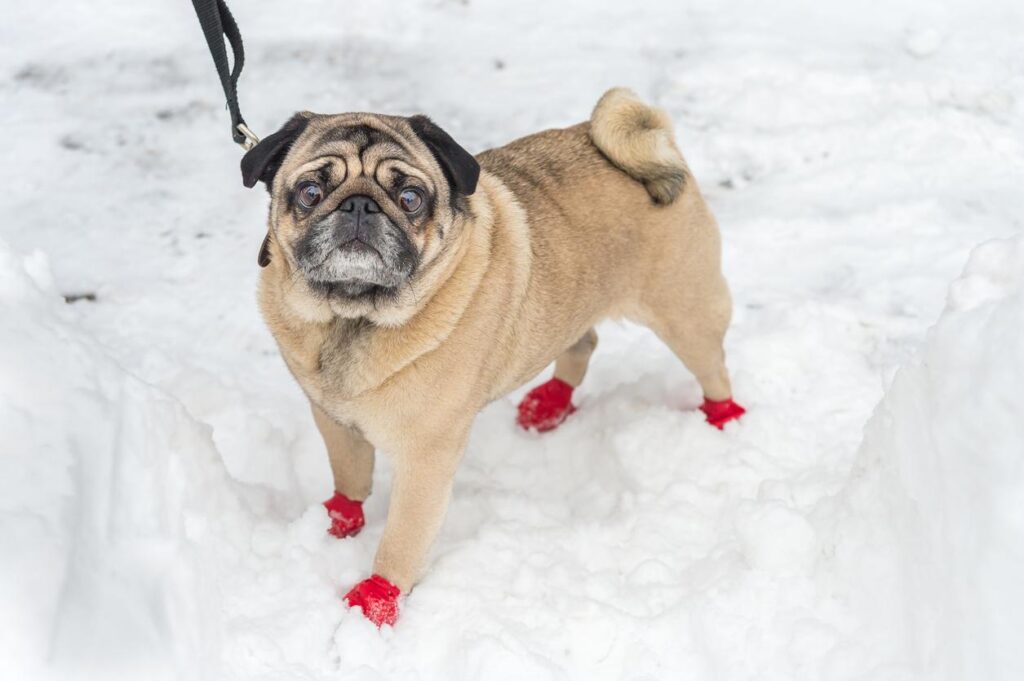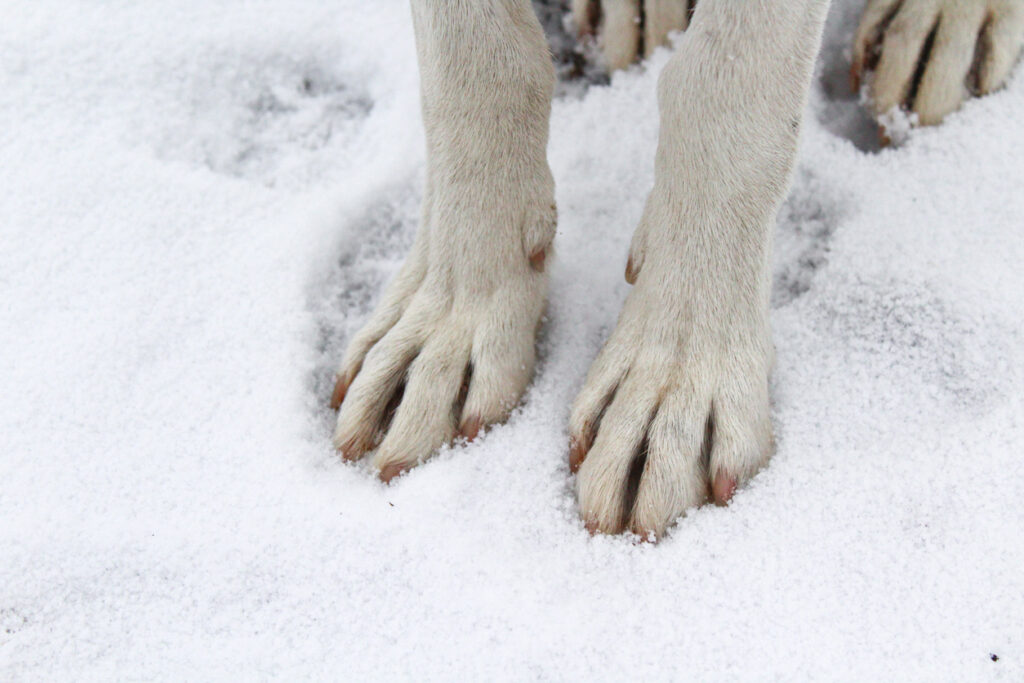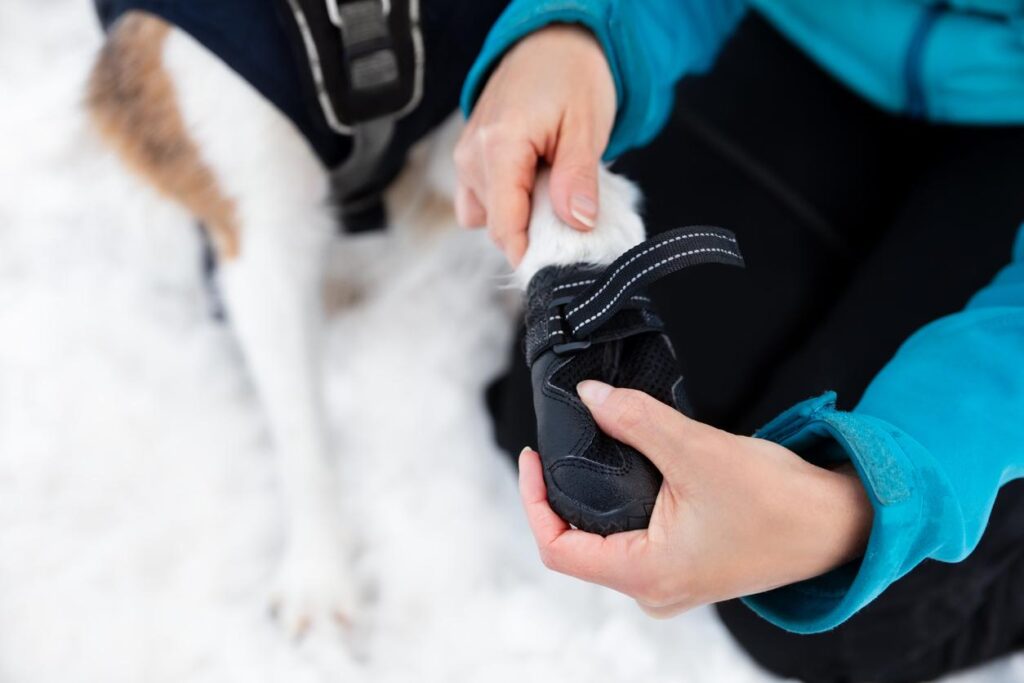
When the temperature drops and the snow starts falling, many pet parents wonder if they should invest in snow boots for their furry companions. We’ve all seen those adorable photos of dogs wearing little boots, but do dogs really need them?
In most cases, dogs are fine going barefoot for short walks in the snow. However, booties can provide protection from extreme cold, salt, and chemical de-icers.
In this blog post, we’ll explore the benefits of booties to help you decide if they’re the right choice for your dog.
Are Dog Paws OK in the Snow?

Dogs are naturally equipped to handle a wide range of temperatures, including cold surfaces. Their paw pads have built-in insulation, which provides some protection against chilly conditions. This means most dogs can tolerate short trips in the snow without any issues.
How Cold is Too Cold For a Dog’s Paws? What Temperature Do Dogs Need Shoes?
While dogs have a natural tolerance for cold surfaces, there’s a limit to their resilience. Extreme cold can be harmful to their paws, just as it would be uncomfortable for us to walk barefoot on ice or freezing pavement. Generally, once temperatures drop below freezing (32°F or 0°C), protecting your dog’s paws is a good idea.
How Long Can Dogs Walk in Snow Without Shoes?
How long your dog can walk in the snow without boots largely depends on the weather conditions and your dog’s breed. Dogs with thicker fur and double coats, like Huskies or Bernese Mountain Dogs, typically have a higher tolerance for cold weather than short-haired breeds.
For dogs well-equipped for the cold, keep walks limited to 30 minutes in freezing weather. Dogs with short hair shouldn’t walk for more than 15 to 20 minutes in freezing weather.
If you protect your dog with a coat and boots, you can generally walk them longer. Just keep an eye on your dog for signs of discomfort and cold, like limping, shivering, whining, or lethargy.
Does My Dog Need Booties in Winter?
While some dogs may tolerate the cold better than others, the use of booties in winter can be beneficial for several reasons. Booties provide an extra layer of insulation, preventing direct contact between your dog’s paws and the cold ground. They also shield against harmful substances like salt and de-icing chemicals, which can be irritating and even toxic if ingested.
In the end, the question of whether your dog needs snow boots comes down to individual circumstances. Consider your location, weather conditions, and your dog’s comfort when deciding if boots are right for your furry companion.
Remember that your dog’s well-being and safety should always be a top priority, whether that means slipping on some stylish snow boots or letting them enjoy a snowy romp barefoot.
How to Protect Your Dog’s Paws in Winter
If you want to protect your dog’s paws during winter walks and playtime, it’s important to understand your dog’s limits as well as how to protect their paws.
Understand When Dogs Should Wear Boots
So, when should you consider putting boots on your furry friend? Here are a few scenarios where dog boots can help keep your dog comfortable and safe.
- Extremely Cold Temperatures: If you live in an area with harsh winters and frequent below-freezing weather, boots are a wise investment.
- Snowy or Icy Conditions: Snow and ice can accumulate between your dog’s toes, causing discomfort and potential injury.
- Salt and De-icers: When your local streets are salted or treated with de-icing chemicals, these substances can harm your dog’s paws.
- Long Walks or Hikes: If you plan extended outdoor adventures in the winter, consider protecting your dog’s paws with boots.
Choose Dog Boots or Paw Wax
There are two main types of paw protectants available to dog owners—dog boots and paw wax. Both help protect your dog’s paw pads from the cold as well as salt, debris, and harsh chemicals.
Dog Booties
Winter dog boots work as an exterior barrier. They help keep your dog warm but also keep salt, ice, and harsh chemicals like deicer away from your dog’s paws.
Most dog boots can be found online or in pet stores. Boots should fit snugly enough that they don’t slip off, but they shouldn’t constrict your dog’s paws.
Paw Wax
If you’d rather use balm instead of booties, choose Vaseline or a wax made specifically for dog paws. Apply a thin layer of wax right before each winter walk. When you return home, wipe your dog’s paws clean to remove snow and any chemicals. Then, apply a fresh layer of wax to moisturize and soothe your dog’s paws.
How to Train a Dog to Wear Boots

Introducing your dog to the idea of wearing boots will take some patience and training. Follow these steps to help your pup adjust to their new winter footwear:
- Start Slowly: Begin by allowing your dog to sniff and investigate the boots. Let them get used to the presence of the boots without wearing them.
- Short Sessions: Gradually increase the time your dog spends wearing the boots, starting with short, positive sessions indoors.
- Use Treats and Praise: Reward your dog with treats and praise when they wear the boots. Positive reinforcement goes a long way.
- Practice Makes Perfect: Practice putting on and taking off the boots until your dog feels comfortable with the process.
- Take Baby Steps: Once your dog is accustomed to indoor wear, venture outside for brief walks to help them adjust to the sensation of walking in boots.
Protect Your Dog’s Health at Portage Park Animal Hospital
If you’re looking to keep your dog happy and healthy, turn to the experts at Portage Park Animal Hospital. Our routine wellness exams provide vital advice and diagnostics to help keep your pup healthy all year long.


